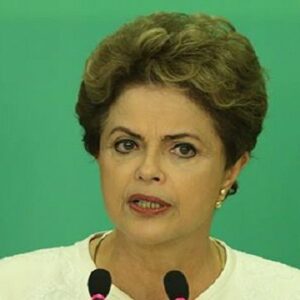Dilma Vana Rousseff is a Brazilian politician and economist who became the country’s first female president in 2011. She fought for democracy, justice, and development for the first time in Brazil when she was 16 years old, following her education at the ‘Central State High School.’ She took to the streets in protest and became involved in organized resistance to military dictatorship, becoming affiliated with a number of leftist and Marxist urban guerrilla groups. She was eventually apprehended, imprisoned, and tortured, and it was only after her release that she was able to start over with a new perspective. She excelled in her personal life, as well as in education, self-development, and Brazil’s current political scene. In Rio Grande do Sul, she was instrumental in the formation of the Democratic Labour Party (PDT). She made a significant contribution to her state’s energy efficiency while serving as Secretary of Energy, Mines, and Communication, and then as Minister of Mines and Energy for a few years. She served as President Luiz Inácio Lula da Silva’s Chief of Staff from 2005 to 2010. She ran for president shortly after, and was sworn in on January 1, 2011, after winning.
Childhood and Adolescence
Rousseff was born in Belo Horizonte, Brazil, to Bulgarian lawyer Pedro Rousseff and schoolteacher Dilma Jane da Silva. She grew up with two siblings, Igor and Zana, in an upper-middle-class family.
She attended ‘Our Lady of Sion’ and then ‘Central State High School,’ where she was introduced to the local political scene for the first time by journalist Cláudio Galeno Linhares, whom she married in 1968.
With her left-wing ideals, she became actively involved in the resistance against dictatorship (established by a military coup) as a teenager. She joined ‘Worker’s Politics,’ and later became a member of the militant group ‘National Liberation Command.’
She was arrested in a bar in So Paulo on January 16, 1970, and tortured in various ways, including the use of electric shocks. She was imprisoned for almost three years. She was released at the end of 1972 and relocated to Porto Alegre, where she began a new life.
Career of Dilma
After resuming her education, she earned a bachelor’s degree in economics from the Federal University of Rio Grande do Sul in 1977, and as the dictatorship’s grip loosened, she gradually returned to politics.
She served as Secretary of Finance for Porto Alegre from 1986 to 1988, and then as Secretary of Mines, Energy, and Communication from 1993 to 1995, where she made a significant contribution to improving energy efficiency and power production in Rio Grande do Sul.
When Luiz Inácio Lula da Silva became President in 2003, he appointed Rousseff to the position of Minister of Mines and Energy. Since Lula’s term as president was limited to two years by constitutional law, she was appointed Chief of Staff in 2005, and he began grooming her to be his successor.
By 2010, she had fully committed to the presidential campaign, promising to uphold Lula’s reforms and policies and garnering widespread support.
She won the election on October 31, 2010, with over 56 percent of valid votes, and was sworn in as President of Brazil on January 1, 2011.
Her domestic agenda as President of Brazil included ensuring economic stability, combating poverty, tax and political reforms, and, of course, job creation. Her foreign policies bolstered Brazil’s position and influence in the international political arena.
There were allegations of political corruption throughout her administration, which resulted in the resignation of five cabinet ministers and the arrest of six government officials, two of whom she fired herself.
These corruptions were already in place, and Lula was accused of being involved in a scandal in which members of the ‘Chamber of Deputies’ were bribed (mensalo).
Rousseff was re-elected president on October 26, 2014, with a narrow margin of victory of 51.64 percent votes, and she is still in office.
Achievements & Awards
Dilma Vana Rousseff’s four-year presidency was marked by upheaval in the poor’s and Brazilian citizens’ living conditions in general.
According to statistics, over 36 million Brazilians have been lifted out of poverty, new job opportunities have been created, and the minimum wage has increased by 72 percent above inflation.
During her four-year term, she promised to raise R$ 635 billion for health and education resources over the next 35 years, as well as R$ 368 billion for the Social Fund.
She was ranked third in 2011, second in 2013, and fourth in 2014 on Forbe’s list of the world’s most powerful women. She was ranked 16th on their list of the world’s most powerful people, and ranked third among women.
In New York, she was awarded the ‘Woodrow Wilson Public Service Award,’ and the next day, she became the first woman to open a session of the ‘United Nations General Assembly.’
Other international honors include Bulgaria’s ‘Cordon of the Order of Stara Planina’ (2011) and Spain’s ‘Knight of the Collar of the Order of Isabella the Catholic’ (2012). (2014).
Personal History and Legacy
From 1968 to 1981, Rousseff was married to journalist Cláudio Galeno Linhares. Their divorce was finalized in 1981 after they had been separated since the early 1970s.
She married Carlos Franklin Paixo de Arajo, with whom she had her first and only child, Paula Rousseff, shortly after her divorce from Galeno. In the year 2000, the couple divorced.
She enjoys history and opera, and was once obsessed with Greek mythology to the point of enrolling in a Greek theatre.
Rousseff was diagnosed with lymphoma, which was treated with chemotherapy, resulting in myopathy. She was treated and eventually recovered.
Estimated Net Worth
Her net worth is estimated to be $1 million.
Trivia
She wore a wig while undergoing cancer treatment. ‘The Iron Lady of Brazil,’ as she is affectionately known.


